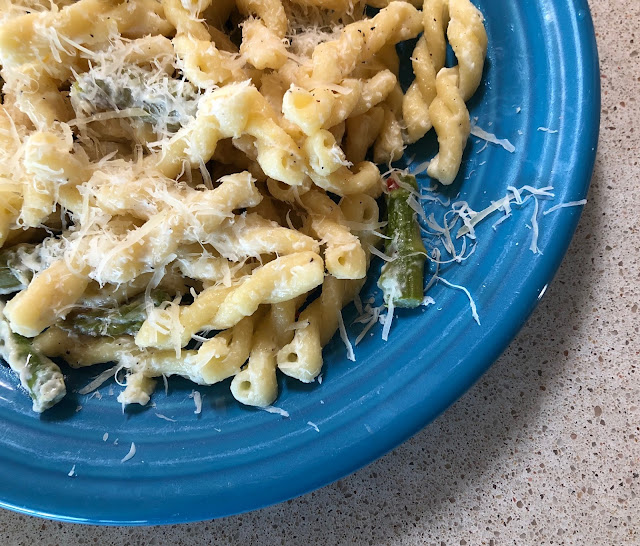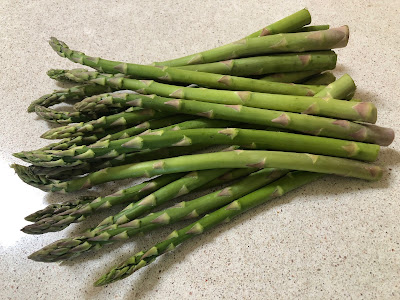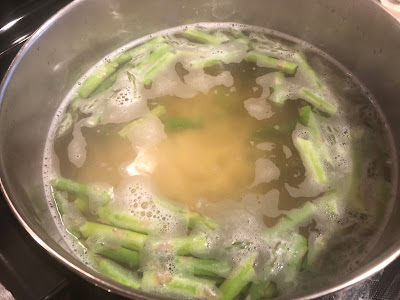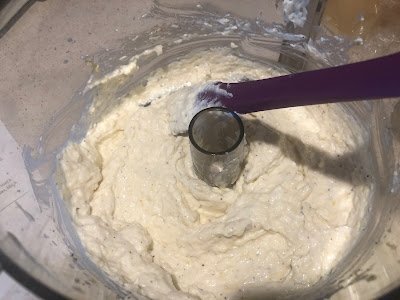
Recipe: No-cook sauce includes ricotta and lemon
 |
|
This pasta recipe goes together quickly and makes a spectacular lunch dish.
(Photos: Kathy Morrison)
|
 |
|
That's a pound of spring right there, pre-trimming.
|
Go ahead, get more asparagus. It's the height of the season and there are plenty of ways to cook it.
This dish features asparagus that's on the thinner side, because it cooks quickly in the same water later used for the pasta. The sauce doesn't cook at all -- how easy is that?
I blended the sauce in my food processor, but you can use an immersion blender or even a hand mixer to get it nice and smooth. Versions of ricotta and pasta are all over the place, but this one -- adapted freely from a New York Times version -- has a nice bite, with red pepper flakes and lemon cutting through the richness of the sauce. Be sure to use whole-milk ricotta, however, for the best texture.
Not a fan of asparagus? Fresh peas would work just as well, and be equally spring-like.
Pasta with asparagus, ricotta and lemon
Serves 4
Ingredients:
3/4 to 1 pound skinny spears of asparagus (or 1 cup of peas)
Kosher salt
1 pound dried short pasta, such as penne, gemelli or farfalle
1 cup whole-milk ricotta cheese
1 cup freshly grated Parmesan cheese, plus more for serving
1 tablespoon freshly grated lemon zest plus 1/4 cup lemon juice (from 1 or 2 lemons)
Freshly ground black pepper
1/8 to 1/4 teaspoon red pepper flakes, or to taste
 |
| The skinny asparagus pieces cook quickly. |
Instructions:
Bring a large pot (at least 4-quart size) of water to boil. Trim the asparagus spear ends, then cut the spears into 2- to 3-inch pieces. Add the asparagus to the water and cook just until tender -- this will go quickly, so don't walk away.
Lift the asparagus out of the water with tongs or a slotted spoon and set it in a colander to dry a bit, then put the asparagus in a bowl and set aside. Don't dump the water from the pot! Bring it back to a boil and add a touch of salt, then add the pasta. Cook pasta according to package directions to al dente. Save 1 cup of the pasta water, then drain the pasta.
 |
| The sauce is blended in a food processor. |
While the pasta is cooking, make the sauce: In a food processor (or with another method noted above) blend together the ricotta, 1 cup of the Parmesan, the lemon zest and juice, 1/2 teaspoon salt, 1/2 teaspoon freshly ground pepper, and the red pepper flakes. Blend in 1/2 cup of the pasta water.
When the pasta is cooked and draining, pour the sauce into the still-warm pot. Add the pasta, stirring gently to blend, and the cooked asparagus pieces. Add a bit more pasta water as needed.
Serve immediately, topped with more Parmesan and freshly ground pepper.
Comments
0 comments have been posted.Sacramento Digs Gardening to your inbox.
Food in My Back Yard Series
April 1: Don't be fooled by these garden myths
March 25: Fertilizer tips: How to 'feed' your vegetables for healthy growth
March 18: Time to give vegetable seedlings some more space
March 11: Ways to win the fight against weeds
March 4: Potatoes from the garden
Feb. 25: Plant a fruit tree now -- for later
Feb. 18: How to squeeze more food into less space
Feb. 11: When to plant? Consider staggering your transplants
Feb. 4: Starting in seed starting
Sites We Like
Garden Checklist for week of March 30
Your garden doesn’t mind April showers. Get busy now to enjoy those future flowers.
* Get ready to swing into action in the vegetable garden. As nights warm up over 50 degrees, start setting out tomato, pepper and eggplant transplants.
* From seed, plant beans, beets, cantaloupes, carrots, corn, cucumbers, melons, pumpkins, radishes and squash. (Soak beet seeds overnight in water for better germination,)
* Plant onion sets.
* In the flower garden, plant seeds for asters, cosmos, celosia, marigolds, salvia, sunflowers and zinnias.
* Transplant petunias, zinnias, geraniums and other summer bloomers.
* Plant perennials and dahlia tubers for summer bloom.
* Transplant lettuce and cabbage seedlings.
* April is the last chance to plant citrus trees such as dwarf orange, lemon and kumquat. These trees also look good in landscaping and provide fresh fruit in winter.
* Smell orange blossoms? Feed citrus trees with a low dose of balanced fertilizer (such as 10-10-10) during bloom to help set fruit. Keep an eye out for ants.
* Apply slow-release fertilizer to the lawn.